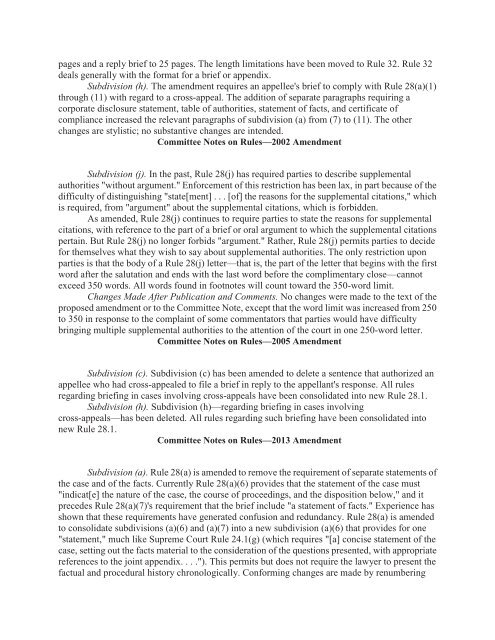Federal Rules of Appellate Procedure 2014-2015, 2014a
Federal Rules of Appellate Procedure 2014-2015, 2014a
Federal Rules of Appellate Procedure 2014-2015, 2014a
You also want an ePaper? Increase the reach of your titles
YUMPU automatically turns print PDFs into web optimized ePapers that Google loves.
pages and a reply brief to 25 pages. The length limitations have been moved to Rule 32. Rule 32<br />
deals generally with the format for a brief or appendix.<br />
Subdivision (h). The amendment requires an appellee's brief to comply with Rule 28(a)(1)<br />
through (11) with regard to a cross-appeal. The addition <strong>of</strong> separate paragraphs requiring a<br />
corporate disclosure statement, table <strong>of</strong> authorities, statement <strong>of</strong> facts, and certificate <strong>of</strong><br />
compliance increased the relevant paragraphs <strong>of</strong> subdivision (a) from (7) to (11). The other<br />
changes are stylistic; no substantive changes are intended.<br />
Committee Notes on <strong>Rules</strong>—2002 Amendment<br />
Subdivision (j). In the past, Rule 28(j) has required parties to describe supplemental<br />
authorities "without argument." Enforcement <strong>of</strong> this restriction has been lax, in part because <strong>of</strong> the<br />
difficulty <strong>of</strong> distinguishing "state[ment] . . . [<strong>of</strong>] the reasons for the supplemental citations," which<br />
is required, from "argument" about the supplemental citations, which is forbidden.<br />
As amended, Rule 28(j) continues to require parties to state the reasons for supplemental<br />
citations, with reference to the part <strong>of</strong> a brief or oral argument to which the supplemental citations<br />
pertain. But Rule 28(j) no longer forbids "argument." Rather, Rule 28(j) permits parties to decide<br />
for themselves what they wish to say about supplemental authorities. The only restriction upon<br />
parties is that the body <strong>of</strong> a Rule 28(j) letter—that is, the part <strong>of</strong> the letter that begins with the first<br />
word after the salutation and ends with the last word before the complimentary close—cannot<br />
exceed 350 words. All words found in footnotes will count toward the 350-word limit.<br />
Changes Made After Publication and Comments. No changes were made to the text <strong>of</strong> the<br />
proposed amendment or to the Committee Note, except that the word limit was increased from 250<br />
to 350 in response to the complaint <strong>of</strong> some commentators that parties would have difficulty<br />
bringing multiple supplemental authorities to the attention <strong>of</strong> the court in one 250-word letter.<br />
Committee Notes on <strong>Rules</strong>—2005 Amendment<br />
Subdivision (c). Subdivision (c) has been amended to delete a sentence that authorized an<br />
appellee who had cross-appealed to file a brief in reply to the appellant's response. All rules<br />
regarding briefing in cases involving cross-appeals have been consolidated into new Rule 28.1.<br />
Subdivision (h). Subdivision (h)—regarding briefing in cases involving<br />
cross-appeals—has been deleted. All rules regarding such briefing have been consolidated into<br />
new Rule 28.1.<br />
Committee Notes on <strong>Rules</strong>—2013 Amendment<br />
Subdivision (a). Rule 28(a) is amended to remove the requirement <strong>of</strong> separate statements <strong>of</strong><br />
the case and <strong>of</strong> the facts. Currently Rule 28(a)(6) provides that the statement <strong>of</strong> the case must<br />
"indicat[e] the nature <strong>of</strong> the case, the course <strong>of</strong> proceedings, and the disposition below," and it<br />
precedes Rule 28(a)(7)'s requirement that the brief include "a statement <strong>of</strong> facts." Experience has<br />
shown that these requirements have generated confusion and redundancy. Rule 28(a) is amended<br />
to consolidate subdivisions (a)(6) and (a)(7) into a new subdivision (a)(6) that provides for one<br />
"statement," much like Supreme Court Rule 24.1(g) (which requires "[a] concise statement <strong>of</strong> the<br />
case, setting out the facts material to the consideration <strong>of</strong> the questions presented, with appropriate<br />
references to the joint appendix. . . ."). This permits but does not require the lawyer to present the<br />
factual and procedural history chronologically. Conforming changes are made by renumbering


















